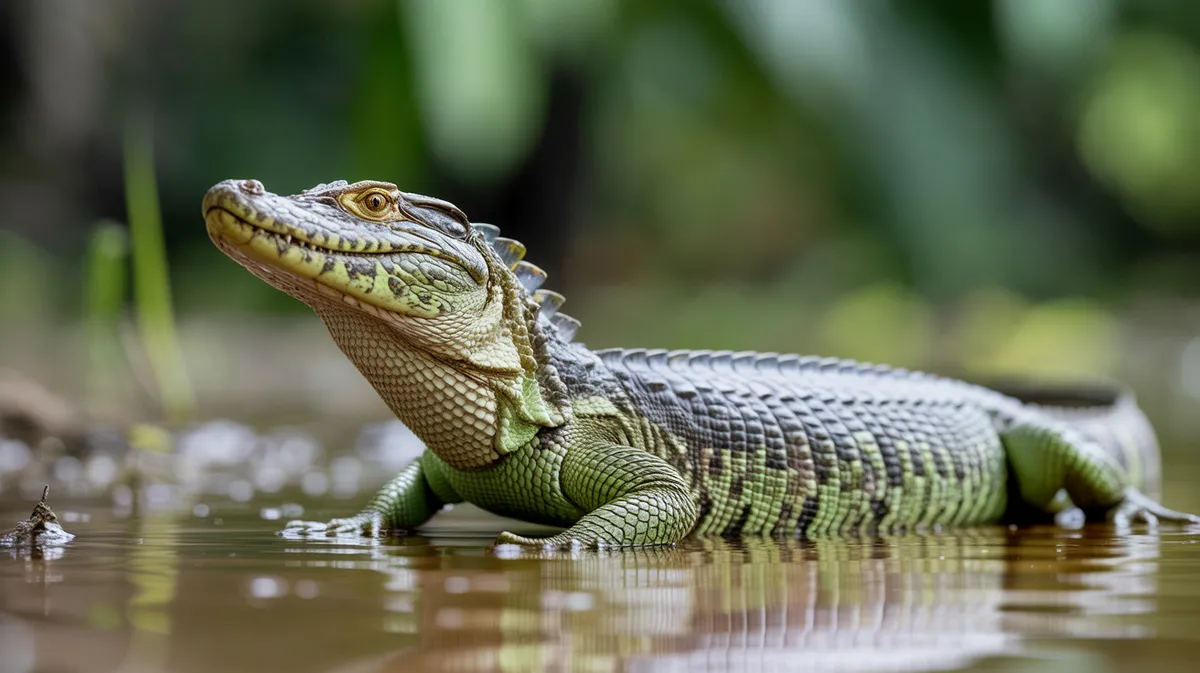
Caiman Lizard
Dracaena guianensis

Meet the Caiman Lizard
The Caiman Lizard is a large, semi-aquatic reptile native to the wetlands and flooded forests of South America, particularly the Amazon Basin. Its body is robust and covered with thick, armored scales reminiscent of a caiman crocodile, especially along its back and tail. Adapted for an aquatic lifestyle, the Caiman Lizard has strong limbs, a laterally flattened tail for swimming, and powerful jaws capable of crushing hard-shelled prey. Its coloration is striking, with a bright green body and a reddish-orange head, making it a visually distinctive species. This lizard spends much of its time basking on branches overhanging water, diving in to escape predators or to hunt.
Classification
Reptile
Habitat
Flooded forests and wetlands
Diet
Carnivore
Lifespan
10-12 years
Conservation
Least Concern
Weight
2-5 kg
📖Fascinating Facts
Crocodilian Resemblance
The Caiman Lizard gets its name due to its armored scales and powerful tail, which closely resemble those of actual caimans.
Snail Specialist
Its diet primarily consists of aquatic snails, which it crushes with its strong, broad teeth and jaws designed for breaking shells.
Aquatic Adaptation
Caiman Lizards are excellent swimmers and spend much of their time in the water, using their laterally flattened tail to propel themselves efficiently.
📋Detailed Description
The Caiman Lizard (Dracaena guianensis) is a robust, semi-aquatic lizard reaching lengths of 90–120 cm (3–4 ft) and weighing up to 4–6 kg. Its body is covered in large, rectangular, heavily keeled scales, especially pronounced along the dorsal surface, providing armor-like protection reminiscent of caiman crocodilians. The head is broad and wedge-shaped, often displaying a vivid reddish or orange coloration that contrasts with the bright green to olive body. The tail is laterally compressed, making up about half the total body length, and is highly adapted for swimming. The lizard's jaws are exceptionally strong, equipped with blunt, molariform teeth designed to crush the hard shells of its primary prey, such as snails and freshwater mollusks. Eyes and nostrils are positioned high on the head, facilitating submerged hunting. Caiman Lizards possess muscular limbs with long, sharp claws for climbing and gripping wet, slippery branches. Their skin is water-repellent, aiding in thermoregulation and buoyancy. Sexual dimorphism is subtle, with males sometimes exhibiting slightly larger heads and brighter coloration. This species is primarily diurnal, spending daylight hours basking and foraging, and is known for its secretive nature and agility both in water and on land.
💡 Did you know?
The Caiman Lizard's tongue is forked, much like a snake's, which it uses to sense chemical cues in its environment.
🔬Research & Sources
Wikipedia Summary
Dracaena, is a genus of lizards, also commonly called caiman lizards or water tegus, in the family Teiidae, along with tegus and ameivas. Caiman lizards are native to South America, where they are found in Brazil, Colombia, Ecuador, Paraguay, and Peru. These semiaquatic lizards spend a lot of time in the water and inhabit marshes, streams, and flooded forests. Caiman lizards often bask on branches overhanging the water.
Last Modified: 2/19/2025
🎭Behavior & Social Structure
Caiman Lizards are solitary and territorial, with individuals maintaining overlapping home ranges along watercourses. They are primarily active during the day (diurnal), often seen basking on low branches overhanging water, which allows for rapid escape by diving if threatened. Their feeding behavior is highly specialized: they use their powerful jaws to crush the shells of aquatic snails, their main prey, but will also consume crustaceans, fish, insects, and occasionally small vertebrates. Prey is located visually and by scent, captured with a rapid strike, and manipulated in the mouth to position it for optimal crushing. Caiman Lizards exhibit a sit-and-wait hunting strategy, remaining motionless for extended periods before ambushing prey. Social interactions are limited outside of the breeding season, with occasional displays of aggression (head bobbing, tail lashing) to establish dominance or defend territory. At night, they retreat to dense vegetation or burrows near water for safety.
👶Reproduction & Life Cycle
Breeding in Caiman Lizards generally coincides with the onset of the rainy season (typically November to March, depending on region). Males engage in courtship displays, including head bobbing and body posturing, to attract females. Copulation occurs on land or in shallow water. Females lay clutches of 5–7 leathery eggs in burrows excavated in sandy or soft soil above the flood line. Incubation lasts approximately 90–100 days at optimal temperatures (28–30°C). Hatchlings are fully independent at birth, measuring about 20–25 cm in length, and receive no parental care. Juveniles are more secretive and spend more time in dense cover to avoid predation. Sexual maturity is reached at 2–3 years of age.
🛡️Adaptations & Survival
Caiman Lizards exhibit several remarkable adaptations for a semi-aquatic lifestyle. Their laterally compressed tails provide powerful propulsion in water, while their nostrils and eyes are positioned dorsally to allow breathing and vision while mostly submerged. The robust, molariform teeth and exceptionally strong jaw muscles are specialized for durophagy (eating hard-shelled prey). Their thick, keeled scales offer protection from predators and abrasive aquatic environments. Water-repellent skin reduces drag and aids in thermoregulation. Behavioral adaptations include basking to regulate body temperature and the ability to remain submerged for up to 30 minutes to avoid detection. Their coloration provides camouflage among aquatic vegetation and sun-dappled branches.
📚Research Sources
🎨Cultural Significance
Caiman Lizards are not widely featured in indigenous mythology or folklore, likely due to their secretive habits. However, in some Amazonian communities, they are occasionally hunted for their meat or skin, though this is less common today. In the international pet trade, their striking appearance has made them increasingly popular, though they require specialized care. Their resemblance to caiman crocodilians has led to confusion and contributed to their mystique in local cultures.
🔬Recent Research & Discoveries
Recent research has focused on the biomechanics of the Caiman Lizard's jaw and teeth, revealing convergent evolution with other durophagous reptiles. Studies on their ecological role highlight their importance in controlling populations of aquatic snails, some of which are vectors for parasitic diseases. Ongoing fieldwork is examining their population genetics and responses to habitat fragmentation. Captive breeding programs have improved understanding of their reproductive biology, aiding both conservation and the exotic pet industry. There is growing interest in their potential as bioindicators for wetland health due to their sensitivity to water quality and habitat changes.
🎥Wildlife Videos

Wildlife | Episode 2: Crocodiles, Alligators, Caimans & Gharials | Free Documentary Nature
Wildlife: Episode 2 - Crocodiles, Alligators, Caimans & Gharials | Wildlife Documentary Watch 'Wildlife - Episode 3: Kangaroos' ...
Free Documentary - Nature

The Surprising Truth About Caiman Lizards Nobody Tells You
Discover the incredible Caiman Lizard, a prehistoric-looking reptile that roams the swamps and forests of Central and South ...
Nat Geo Wilder

Wildlife - Just Reptiles | Free Documentary Nature
Wildlife - Episode 3: Just Reptiles | Wildlife Documentary Watch 'Wildlife - Episode 4' here: https://youtu.be/SNRyvGzDsww ...
Free Documentary - Nature

Australia’s Remarkable Reptiles - Lizards of Oz | Full Documentary
Australia is the driest inhabited continent on the planet with much of the inland being a virtual desert. However, cold blooded ...
Free High-Quality Documentaries

Caiman Lizard facts: the water tegu | Animal Fact Files
Caiman lizards are named so because they have large, thick scales that resemble the scales found on caimans. These two ...
Animal Fact Files

Caiman Lizard: The Lizard with a Croc-Like Armor! 🐊🦎
Caiman Lizard: The Lizard with a Croc-Like Armor! Did you know the Caiman Lizard looks like a mix between a crocodile ...
Ases World
🌍Habitat Information
The Caiman Lizard typically inhabits Flooded forests and wetlands environments. Caiman Lizards have adapted to their environments with specialized features and behaviors.
Primary Habitat:
Flooded forests and wetlands
More detailed habitat information will be available soon.
🛡️Conservation Status
The Caiman Lizard is currently classified as Least Concern. Conservation efforts are crucial for preserving this species for future generations.
Common Threats:
- 🏠Habitat loss and fragmentation
- 🌡️Climate change impacts
- 🎯Hunting and poaching
- 🏭Human-wildlife conflict
⚠️Threats & Conservation Challenges
While currently listed as Least Concern by the IUCN, Caiman Lizards face localized threats from habitat loss due to deforestation, wetland drainage, and pollution. Illegal collection for the pet trade and hunting for their skins (historically used in leather goods) have also impacted some populations. Water pollution and the introduction of invasive species may reduce prey availability. Climate change poses long-term risks by altering flood regimes and habitat structure. Despite these challenges, the species remains relatively widespread and adaptable, though continued monitoring is recommended.
🔬Scientific Classification
Scientific Name
Dracaena guianensis
Classification Hierarchy
🔍 About Taxonomic Classification
Taxonomic classification is a hierarchical system used by scientists to classify and organize living organisms based on shared characteristics and evolutionary relationships.
The system moves from broad categories (Kingdom) to increasingly specific ones, with each animal's scientific name typically consisting of its Genus and species.
📝Community Notes
Share your observations and insights about the Caiman Lizard with our community of wildlife enthusiasts.
Join Our Community
Sign in to share your observations and connect with fellow wildlife enthusiasts.
Sign In to ContributeNo community notes yet
Be the first to share your observations about the Caiman Lizard!
Explore Caiman Lizard
Select a tab above to learn more about this amazing animal.
📸Photo Gallery
No photos available for this animal yet.
🌟Discover More Wildlife
Continue your journey of discovery with more fascinating animals from our database
